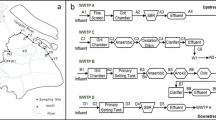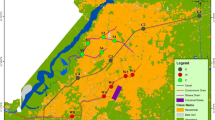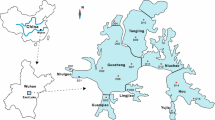Abstract
Chemicals in the water of urban areas are representative of the occurrence of these chemicals in the city surrounding water systems and reflect recent human or industrial usage of those chemicals in the sampling areas. In this study, the levels of eight endocrine-disrupting chemicals [including bisphenol analogues, parabens, and triclosan (TCS)] were determined in urban river water and sediments in Guangzhou, South China, and their related ecological risks were evaluated. The eight target chemicals were frequently detected in our samples, with concentrations ranging from not detected (ND) to 65,600 ng/L and from ND to 492 ng/g dw in river water and sediments, respectively. Among these chemicals, the three most abundant were bisphenol A (BPA) (accounting for 35% of the total amount), methyl paraben (MeP) (23%), and TCS (14%) in river water and BPA (43%), TCS (37%), and MeP (14%) in sediments. Significant correlations were found between most target EDCs, particularly MeP and TCS, in river water and sediments (both p < 0.01), indicating their similar sources and wide usage. The ecological risk assessment methods used suggested that TCS was the chemical of primary concern, with an average hazard quotient (HQ) = 1.57 (up to 11.5) in river water and an average HQ = 0.74 (up to 3.63) in sediments. In addition, the ecological risk assessment of different sampling sites indicated a suspected high-risk level for some sites in the study area.





Similar content being viewed by others
References
Asimakopoulos AG, Elangovan M, Kannan K (2016) Migration of parabens, bisphenols, benzophenone-type UV filters, triclosan, and triclocarban from teethers and its implications for infant exposure. Environ Sci Technol 50:13539–13547
Bledzka D, Gromadzinska J, Wasowicz W (2014) Parabens. From environmental studies to human health. Environ Int 67:27–42
Carmona E, Andreu V, Pico Y (2014) Occurrence of acidic pharmaceuticals and personal care products in Turia River Basin: from waste to drinking water. Sci Total Environ 484:53–63
Chen M-Y, Ike M, Fujita M (2002) Acute toxicity, mutagenicity, and estrogenicity of bisphenol-A and other bisphenols. Environ Toxicol 17:80–86
Chen D, Kannan K, Tan H, Zheng Z, Feng Y-L, Wu Y, Widelka M (2016) Bisphenol analogues other than BPA: environmental occurrence, human exposure, and toxicity—a review. Environ Sci Technol 50:5438–5453
Darbre PD, Harvey PW (2008) Paraben esters: review of recent studies of endocrine toxicity, absorption, esterase and human exposure, and discussion of potential human health risks. J Appl Toxicol 28:561–578
Dhillon GS, Kaur S, Pulicharla R, Brar SK, Cledon M, Verma M, Surampalli RY (2015) Triclosan: current status, occurrence, environmental risks and bioaccumulation potential. Int J Environ Res Public Health 12:5657–5684
Dobbins LL, Usenko S, Brain RA, Brooks BW (2009) Probabilistic ecological hazard assessment of parabens usingdaphnia magna and pimephales promelas. Environ Toxicol Chem 28:2744–2753
Golden R, Gandy J, Vollmer G (2005) A review of the endocrine activity of parabens and implications for potential risks to human health. Crit Rev Toxicol 35:435–458
Gong J, Ran Y, Chen D, Yang Y, Ma X (2009) Occurrence and environmental risk of endocrine-disrupting chemicals in surface waters of the Pearl River, South China. Environ Monit Assess 156:199–210
Gong J, Ran Y, Chen DY, Yang Y (2011) Occurrence of endocrine-disrupting chemicals in riverine sediments from the Pearl River Delta, China. Mar Pollut Bull 63:556–563
Guo Y, Kannan K (2013) A survey of phthalates and parabens in personal care products from the United States and its implications for human exposure. Environ Sci Technol 47:14442–14449
Guo Y, Wang L, Kannan K (2014) Phthalates and parabens in personal care products from China: concentrations and human exposure. Arch Environ Contam Toxicol 66:113–119
Hernando MD, Mezcua M, Fernandez-Alba AR, Barcelo D (2006) Environmental risk assessment of pharmaceutical residues in wastewater effluents, surface waters and sediments. Talanta 69:334–342
Huang YQ et al (2012) Bisphenol A (BPA) in China: a review of sources, environmental levels, and potential human health impacts. Environ Int 42:91–99
Ike M, Chen MY, Danzl E, Sei K, Fujita M (2006) Biodegradation of a variety of bisphenols underaerobic and anaerobic conditions. Water Sci Technol 53:153–159
Inui M et al (2003) Effect of UV screens and preservatives on vitellogenin and choriogenin production in male medaka (Oryzias latipes). Toxicology 194:43–50
Jin H, Zhu L (2016) Occurrence and partitioning of bisphenol analogues in water and sediment from Liaohe River Basin and Taihu Lake, China. Water Res 103:343–351
Kasprzyk-Hordern B, Dinsdale RM, Guwy AJ (2008) The occurrence of pharmaceuticals, personal care products, endocrine disruptors and illicit drugs in surface water in South Wales, UK. Water Res 42:3498–3518
Lee HB, Peart TE, Svoboda ML (2005) Determination of endocrine-disrupting phenols, acidic pharmaceuticals, and personal-care products in sewage by solid-phase extraction and gas chromatography–mass spectrometry. J Chromatogr A 1094:122–129
Liao C, Kannan K (2013) Concentrations and profiles of bisphenol A and other bisphenol analogues in foodstuffs from the United States and their implications for human exposure. J Agric Food Chem 61:4655–4662
Liao C, Kannan K (2014a) Concentrations and composition profiles of parabens in currency bills and paper products including sanitary wipes. Sci Total Environ 475:8–15
Liao C, Kannan K (2014b) A survey of alkylphenols, bisphenols, and triclosan in personal care products from China and the United States. Arch Environ Contam Toxicol 67:50–59
Liao C, Liu F, Guo Y, Moon HB, Nakata H, Wu Q, Kannan K (2012a) Occurrence of eight bisphenol analogues in indoor dust from the United States and several asian countries: implications for human exposure. Environ Sci Technol 46:9138–9145
Liao C, Liu F, Kannan K (2012b) Bisphenol s, a new bisphenol analogue, in paper products and currency bills and its association with bisphenol a residues. Environ Sci Technol 46:6515–6522
Liao C, Liu F, Moon HB, Yamashita N, Yun S, Kannan K (2012c) Bisphenol analogues in sediments from industrialized areas in the United States, Japan, and Korea: spatial and temporal distributions. Environ Sci Technol 46:11558–11565
Liao C, Lee S, Moon HB, Yamashita N, Kannan K (2013) Parabens in sediment and sewage sludge from the United States, Japan, and Korea: spatial distribution and temporal trends. Environ Sci Technol 47:10895–10902
Liu Y et al (2017) Occurrence, distribution and sources of bisphenol analogues in a shallow Chinese freshwater lake (Taihu Lake)-implications for ecological and human health risk. Sci Total Environ 599–600:1090–1098
Orvos DR, Versteed DJ, Inauen J, Capdevielle M, Rothenstien A, Cunninghan V (2002) Aquatic toxicity of triclosan. Environ Toxicol Chem 21:1338–1349
Peng X et al (2017) Persistence, temporal and spatial profiles of ultraviolet absorbents and phenolic personal care products in riverine and estuarine sediment of the Pearl River catchment, China. J Hazard Mater 323:139–146
Peng X, Yu Y, Tang C, Tan J, Huang Q, Wang Z (2008) Occurrence of steroid estrogens, endocrine-disrupting phenols, and acid pharmaceutical residues in urban riverine water of the Pearl River Delta, South China. Sci Total Environ 397:158–166
Pintado-Herrera MG, Wang C, Lu J, Chang YP, Chen W, Li X, Lara-Martin PA (2017) Distribution, mass inventories, and ecological risk assessment of legacy and emerging contaminants in sediments from the Pearl River Estuary in China. J Hazard Mater 323:128–138
Ramaswamy BR, Shanmugam G, Velu G, Rengarajan B, Larsson DGJ (2011) GC-MS analysis and ecotoxicological risk assessment of triclosan, carbamazepine and parabens in Indian rivers. J Hazard Mater 186:1586–1593
Singer H, Muller S, Tixier C, Pillonel L (2002) Triclosan-Occurrence and fate of a widely used biocide in the aquatic environment—field measurements in wastewater treatment plants, surface waters, and lake sediments. Environ Sci Technol 36:4998–5004
Tišler T, Krel A, Gerželj U, Erjavec B, Dolenc MS (2016) Hazard identification and risk characterization of bisphenols A, F and AF to aquatic organisms. Environ Pollut 212:472–479
USEPA (2008) Reregistration Eligibility Decision for Triclosan, List B Case No. 2340, Office of Prevention, Pesticides And Toxic Substances https://www3.epa.gov/pesticides/chem_search/reg_actions/reregistration/red_PC-054901_18-Sep-08.pdf. Accessed 18 Sept 2008
Wang J-Z, Guan Y-F, Ni H-G, Luo X-L, Zeng EY (2007) Polycyclic aromatic hydrocarbons in riverine runoff of the Pearl RiverDelta (China): concentrations, fluxes, and fate. Environ Sci Technol 41:5614–5619
Wong KH, Durrani TS (2017) Exposures to endocrine disrupting chemicals in consumer products—a guide for pediatricians. Curr Probl Pediatric Adolesc Health Care 47:107–118
Wu LH et al (2017) Occurrence of bisphenol S in the environment and implications for human exposure: a short review. Sci Total Environ 615:87–98
Xue J, Wan Y, Kannan K (2016) Occurrence of bisphenols, bisphenol A diglycidyl ethers (BADGEs), and novolac glycidyl ethers (NOGEs) in indoor air from Albany, New York, USA, and its implications for inhalation exposure. Chemosphere 151:1–8
Yamazaki E et al (2015) Bisphenol A and other bisphenol analogues including BPS and BPF in surface water samples from Japan, China, Korea and India. Ecotoxicol Environ Saf 122:565–572
Yan Z et al (2017) Bisphenol analogues in surface water and sediment from the shallow Chinese freshwater lakes: occurrence, distribution, source apportionment, and ecological and human health risk. Chemosphere 184:318–328
Yang Y, Lu L, Zhang J, Yang Y, Wu Y, Shao B (2014) Simultaneous determination of seven bisphenols in environmental water and solid samples by liquid chromatography-electrospray tandem mass spectrometry. J Chromatogr A 1328:26–34
Yang Y, Ok YS, Kim K-H, Kwon EE, Tsang YF (2017) Occurrences and removal of pharmaceuticals and personal care products (PPCPs) in drinking water and water/sewage treatment plants: a review. Sci Total Environ 596–597:303–320
Zhao JL, Ying GG, Liu YS, Chen F, Yang JF, Wang L (2010) Occurrence and risks of triclosan and triclocarban in the Pearl River system, South China: from source to the receiving environment. J Hazard Mater 179:215–222
Acknowledgements
The present study was financially supported by the Guangdong Innovative and Entrepreneurial Research Team Program, China (No. 2016ZT06N258); the National Natural Science Funds for Distinguished Young Scholar of Guangdong Province, China (No. 2016A030306015); and the National Natural Science Foundation of China (No. 21577050).
Author information
Authors and Affiliations
Corresponding author
Electronic supplementary material
Below is the link to the electronic supplementary material.
Rights and permissions
About this article
Cite this article
Huang, C., Wu, LH., Liu, GQ. et al. Occurrence and Ecological Risk Assessment of Eight Endocrine-Disrupting Chemicals in Urban River Water and Sediments of South China. Arch Environ Contam Toxicol 75, 224–235 (2018). https://doi.org/10.1007/s00244-018-0527-9
Received:
Accepted:
Published:
Issue Date:
DOI: https://doi.org/10.1007/s00244-018-0527-9




